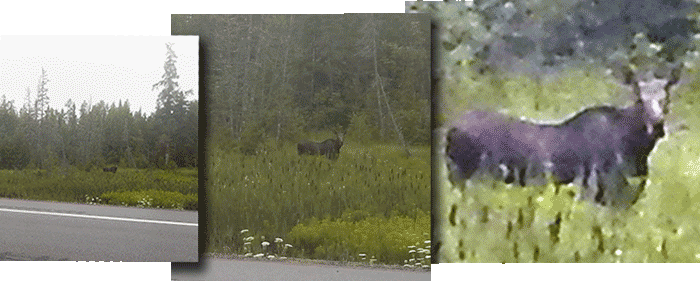
06-19-14
Here’s a few pics Hoolie snapped while traveling US 41, about 3 miles east of Michigamme, the actual Moose capital of the U.P. |
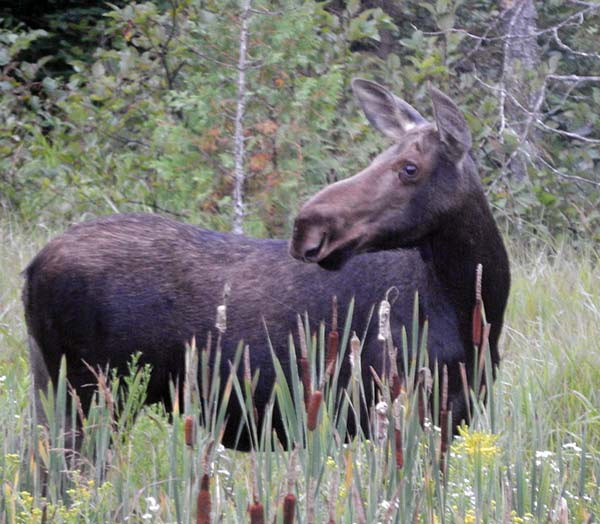
06-19-14
Between Greenwood location and Three Lakes, MI, Hoolie has spotted at least 8 Moose so far! |
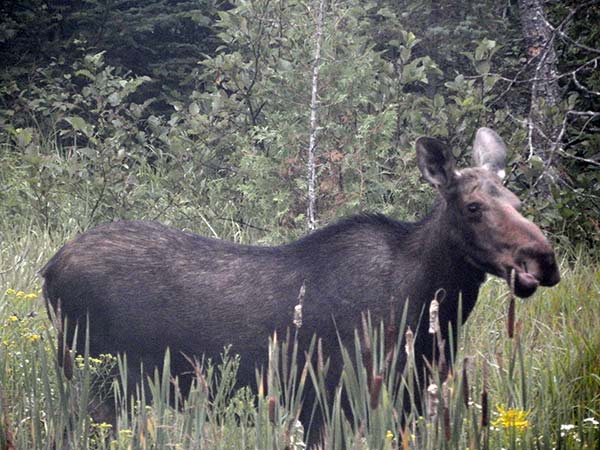
06-19-14
Between May and September, Hoolie travels the U.P. extensively for business matters. He's always sure to carry a camera because you never know what you'll see in da wild U.P. (he's always sure to carry a role of T.P. also, because....) |
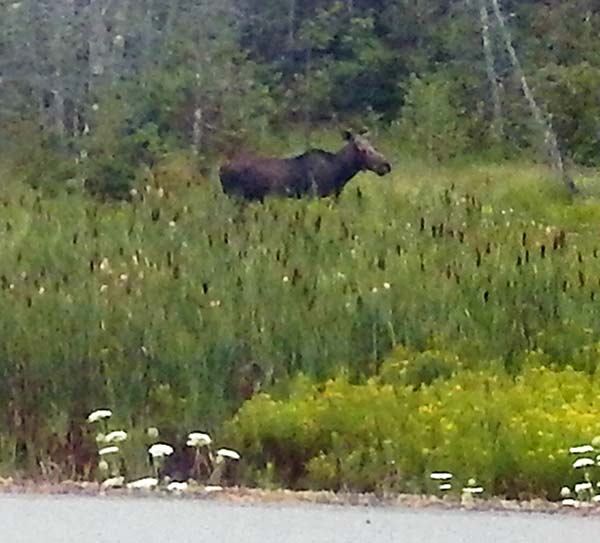
06-19-14
From a distance, and with only trees and swamp for reference, moose may not appear any larger than your average deer. They are in fact much bigger. Their height at the shoulder generally ranges between 6 ½-7 ½ feet (over 2 meters), so, yeah... their big buggers!
We once passed a family that had pulled over on US 41 to observe a Moose. The Parents were standing just outside the car with their cameras while junior; 40 feet or so away, slowly approached the Moose who was an additional 40 feet away. Though I'm sure they snapped a few picks and left without incident, letting junior approach the moose was not very wise.
Moose are not normally aggressive, however, they can be very aggressive when hungry, tired or harassed by people, dogs, and traffic. During the mating season bull moose are often more aggressive toward people. Mothers with young calves are very protective and will attack humans who come too close.
You can identify when a moose might attack if the long hairs on its hump are raised and it's ears laid back. A moose may also lick its lips.
Charges may only be "bluffs", warning you to get back, however take this seriously, even a young calf could cause significant injuries from it's size alone. When a moose does charge, it often kicks forward with its front hooves. Unlike other animals, such as dogs and bears, it's usually a good idea to run from a moose because they won't chase you very far. |
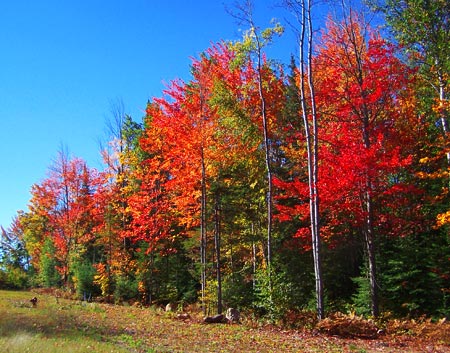 |
Besides
being a sportsmen’s paradise, the Upper Peninsula
of Michigan is also quite beautiful, especially during the
fall color season. |
|
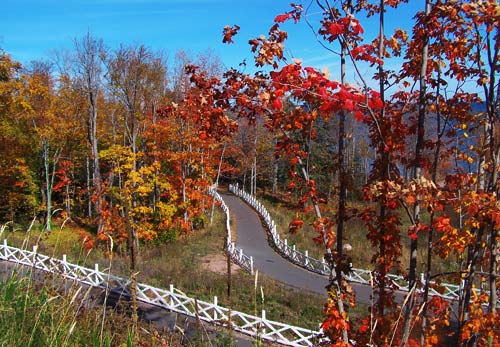 |
Flaming
maples, oaks and other hardwoods can be seen from any road
traveled through the U.P., with trees ranging from a subtle
yellow to brilliant red; creating a stunning backdrop for
the smooth waters of the inland lakes. |
|
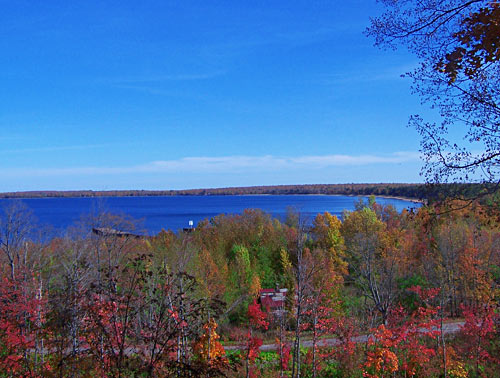 |
A
time of tranquility; our Fall season is when the surrounding
wildlife and we humans prepare for winter. With the evergreens
at their greenest, the skies their bluest and the inland
lakes at their calmest, you can see the frost on the leaves
as everything prepares for the inevitable covering of white.
|
|
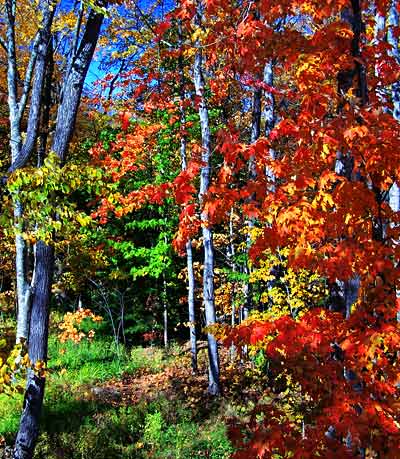 |
For
years, scientists have worked to understand the changes
that happen to trees and shrubs in the autumn. Although
we don't know all the details, we do know enough to explain
the basics and help you to enjoy more fully Nature's multicolored
autumn farewell. Three factors influence
autumn leaf color-leaf pigments, length of night, and weather,
but not quite in the way we think. The timing of color change
and leaf fall are primarily regulated by the calendar, that
is, the increasing length of night. None of the other environmental
influences-temperature, rainfall, food supply, and so on-are
as unvarying as the steadily increasing length of night
during autumn. As days grow shorter, and nights grow longer
and cooler, biochemical processes in the leaf begin to paint
the landscape with Nature's autumn palette. |
|
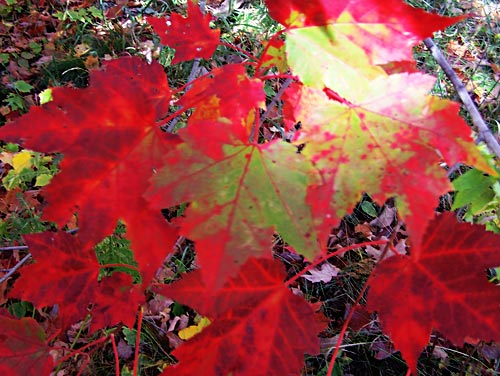 |
A color palette needs pigments,
and there are three types that are involved in autumn color:
Chlorophyll,
which gives leaves their basic green color. It is
necessary for photosynthesis, the chemical reaction
that enables plants to use sunlight to manufacture
sugars for their food. Trees in the temperate zones
store these sugars for their winter dormant period. |
Carotenoids,
which produce yellow, orange, and brown colors in
such things as corn, carrots, and daffodils, as well
as rutabagas, buttercups, and bananas. |
Anthocyanins,
which give color to such familiar things as cranberries,
red apples, concord grapes, blueberries, cherries,
strawberries, and plums. They are water soluble and
appear in the watery liquid of leaf cells. |
|
|
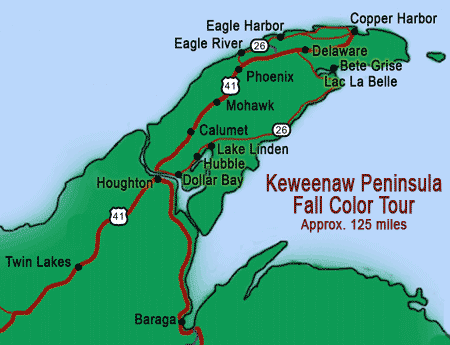 |
Keweenaw
Peninsula Fall Tour
Approx. 125 miles |
Start at Twin
Lakes on M-26, 23 miles south of Houghton. Visit beautiful
Lake Roland while there. Then take 41 north from Houghton
through Calumet, Laurium and Mohawk to Phoenix. Take Highway
26 north from Phoenix through Eagle River and Eagle Harbor
to Copper Harbor. Return from Copper Harbor on Highway
41 to Delaware, then turn on the county road to Bete Grise
and Lac La Belle. Follow this road to Lake Linden where
you will meet Highway 26. Go south to Hubbell, Dollar
Bay and on to Houghton.
|
|
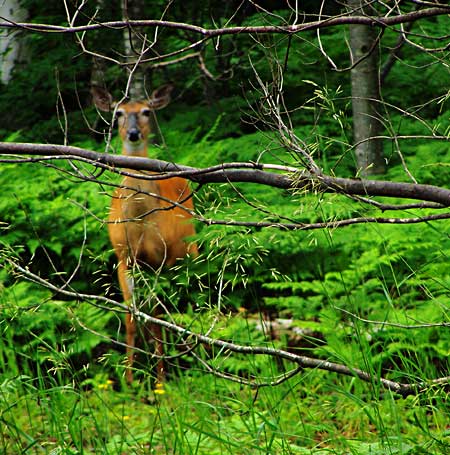 |
We
have a large variety of wildlife also
|
The mammals found
include shrews, moles, mice, white tailed deer, moose,
black bears, gray & red foxes, wolves, river otters,
martens, fishers, bobcats, coyotes, snowshoe hares, cotton-tail
rabbits, chipmunks, squirrels, raccoons and bats.
|
|
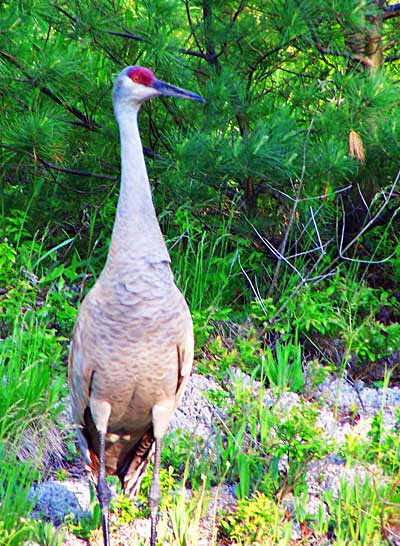 |
Many
birds, including hawks, osprey, gulls, hummingbirds,
chickadees, robins, woodpeckers, warblers, whooping
cranes and bald eagles.
|
|
|
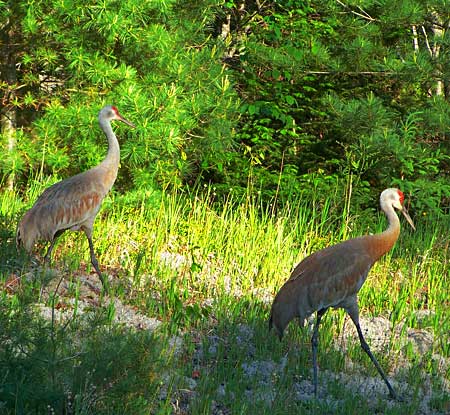 |
Reptiles
and amphibians include common garter snakes, red bellied
snakes, pine snakes, northern water snakes, brown snakes,
eastern garter snakes, eastern fox snakes, smooth green
snakes, northern ringneck snakes, Eastern Milk snakes (Mackinac
and Marquette counties), Eastern Hognose snakes (Menominee
County only), and the very rare U.P. snow snake. also snapping
turtles, wood turtles, and painted turtles (the state reptile),
green frogs, bull frogs, northern leopard frogs, and salamanders.
(don't worry ladies, chances of encountering
a snake while enjoying the U.P. are slim) |
|
|
 |
Lakes
and rivers contain many fish like walleye, Northern Pike,
Trout, Salmon, and bass. The UP also contains many shellfish,
such as clams, aquatic snails, and crayfish. |
|
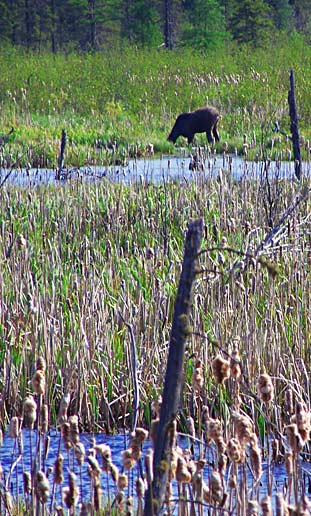 |
Hoolie
loves snapping pics while traveling the U.P., so
there's more to come!
|
|
|
|


